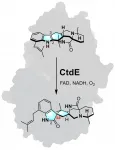Simple blood tests may help improve malaria diagnosis in clinical studies
About one-third of children diagnosed with severe malaria may instead have an alternative cause of illness, but simple blood tests could help researchers distinguish between the two and speed up research on new treatments
2021-07-06
(Press-News.org) Using simple blood tests could help researchers identify children who have been misidentified as having severe malaria, according to a study published today in eLife.
Researchers are working to develop better ways to treat severe malaria, which kills about 400,000 children in Africa each year. The discovery could help expedite such research by helping them more accurately identify children with severe malaria. It also reinforces the importance of the World Health Organization's recommendation that all children being treated for severe malaria also receive antibiotics to ensure any misdiagnosed children receive life-saving care.
Diagnosing severe malaria in children in Africa is challenging because the parasites that cause malaria can be found in both healthy and severely ill children. This makes it difficult to tell if the parasites or some other condition is causing illness. In fact, many children diagnosed with severe malaria may have other life-threatening infections. In addition to potentially delaying life-saving antibiotic care, misdiagnosis can skew the results of studies of new treatments for malaria because children misdiagnosed with malaria will not respond, which could make drugs that work look ineffective.
"Inaccuracy in the diagnosis of severe malaria negatively impacts clinical studies, especially those trying to understand which genes may make people more vulnerable to severe disease, or which treatments are most effective," says co-first author James Watson, Senior Scientist at the Mahidol Oxford Tropical Medicine Research Unit (MORU) in Bangkok, Thailand. "We wanted to know whether complete blood count data, notably platelet counts and white blood cell counts, could help make the diagnosis of malaria more accurate."
Watson, along with co-first author Carolyne Ndila, a researcher at The Kenya Medical Research Institute-Wellcome Trust Research Programme (KWTRP), in Kilifi, Kenya, and their colleagues developed a statistical model that could distinguish between severe malaria and other severe illnesses that can be mistaken as severe malaria. To develop the model they included data from over 1,500 children and adults diagnosed with severe malaria in Thailand and Bangladesh. In these countries, people are rarely misdiagnosed with severe malaria because it is much less common for healthy people to have malaria parasites in their blood.
They applied this model, which relied on platelet and white blood cell counts, to a large cohort of Kenyan children diagnosed with severe malaria. Based on their analysis, they estimate that in approximately one-third of the children, severe malaria was in fact a misdiagnosis.
"Our results support the current guideline that all children with suspected malaria should be given both antimalarials and broad-spectrum antibiotics, as many of the misdiagnosed children will likely have had bacterial sepsis, a severe blood infection," Ndila says.
Using their new model to reanalyse data from clinical studies that looked for potential genetic factors that protect against severe malaria, the team also found that people with glucose-6-phosphate dehydrogenase deficiency probably have some protection from malaria. This benefit was likely obscured in previous studies by the high rate of misdiagnoses.
"We hope our new model can be used by other scientists and clinicians to improve the accuracy of diagnosis in children suspected of having severe malaria," concludes senior author Nicholas White, Professor of Tropical Medicine at Mahidol University. "This will help studies trying to identify better treatments for these patients."
INFORMATION:
Media contacts
Emily Packer, Media Relations Manager
eLife
e.packer@elifesciences.org
+44 (0)1223 855373
John Bleho, Media and Communications
Mahidol Oxford Tropical Medicine Research Unit (MORU)
john@tropmedres.ac
+90 537 567 8460
About eLife
eLife is a non-profit organisation created by funders and led by researchers. Our mission is to accelerate discovery by operating a platform for research communication that encourages and recognises the most responsible behaviours. We aim to publish work of the highest standards and importance in all areas of biology and medicine, including Epidemiology and Global Health, and Genetics and Genomics, while exploring creative new ways to improve how research is assessed and published. eLife receives financial support and strategic guidance from the Howard Hughes Medical Institute, the Knut and Alice Wallenberg Foundation, the Max Planck Society and Wellcome. Learn more at https://elifesciences.org/about.
To read the latest Epidemiology and Global Health research published in eLife, visit https://elifesciences.org/subjects/epidemiology-global-health.
And for the latest in Genetics and Genomics, see https://elifesciences.org/subjects/genetics-genomics.
About MORU
Mahidol Oxford Tropical Medicine Research Unit (MORU), http://www.tropmedres.ac (@MORUBKK), is a research collaboration between Mahidol University (Thailand) and University of Oxford and Wellcome (UK).
ELSE PRESS RELEASES FROM THIS DATE:
2021-07-06
HOUSTON - (July 6, 2021) - A small fungal enzyme could play a significant role in simplifying the development and manufacture of drugs, according to Rice University scientists.
The Rice lab of chemical and biomolecular engineer Xue Sherry Gao and collaborators isolated a biocatalyst known as CtdE after identifying it as the natural mechanism that controls the chirality -- the left- or right-handedness -- of compounds produced by the native fungal host.
The open-access study appears in Nature Communications.
Two chiral things are, like hands, alike in structure but cannot perfectly ...
2021-07-06
Researchers from HSE University and Max Planck Institute for Human Cognitive and Brain Sciences have discovered how the theta rhythm of the brain and the gender differences in attitudes to risk are linked. In an article published in the journal Frontiers in Neuroscience, the researchers addressed which processes can be explained by knowing this connection. https://www.frontiersin.org/articles/10.3389/fnins.2021.608699/full
By transmitting signals, the brain's neurons generate electromagnetic fields. The multiplicity of neurons makes these fields strong enough to be recorded on the surface of the head using magneto- and electroencephalography techniques. ...
2021-07-06
The future of cod stocks in the North Sea and the Barents Sea may be much easier to predict than before. This is the result of an international research project led by the Helmholtz-Zentrum Hereon and its Institute of Coastal Systems - Analysis and Modeling. For the first time, the team has succeeded in predicting the development of stocks for ten years in advance, taking into account both changes due to climate and fishing. Traditionally, fisheries experts provide catch recommendations for about a year in advance, on the basis of which fishing quotas are negotiated and set internationally. This involves first estimating the size of current cod stocks and then calculating how much cod can be caught in the coming year without endangering the stocks ...
2021-07-06
Climate change is causing increased flooding and prolonged waterlogging in northern Europe, but also in many other parts of the world. This can damage meadow grasses, field crops or other plants - their leaves die, the roots rot.
The damage is caused by a lack of oxygen and the accumulation of acids. How do plants perceive this over-acidification, how do they react to it? This is what researchers from Würzburg, Jena (Germany) and Talca (Chile) describe in the journal Current Biology.
Biophysicists Dr. Tobias Maierhofer and Professor Rainer Hedrich from the Chair of Molecular Plant Physiology and Biophysics at Julius-Maximilians-Universität ...
2021-07-06
For the first time, University of Basel researchers have equipped an ultrathin semiconductor with superconducting contacts. These extremely thin materials with novel electronic and optical properties could pave the way for previously unimagined applications. Combined with superconductors, they are expected to give rise to new quantum phenomena and find use in quantum technology.
Whether in smartphones, televisions or building technology, semiconductors play a central role in electronics and therefore in our everyday lives. In contrast to metals, it is possible to adjust their electrical conductivity by applying a voltage and hence to switch the current flow on and off.
With a view to future applications in electronics and quantum technology, researchers are focusing on the development ...
2021-07-06
Abu Dhabi, UAE, July 5, 2021: NYU Abu Dhabi (NYUAD) researchers uncovered a code that sets the genome of the liver to account for the remarkable ability for this organ to regenerate. This finding offers new insight into how the specific genes that promote regeneration can be activated when part of the liver is removed. These findings have the potential to inform the development of a new form of regenerative medicine that could help non-regenerative organs regrow in mice and humans.
While other animals can regenerate most organs, humans, mice, and other mammals can only regenerate their liver in response to an injury or when a piece is removed. NYUAD researchers ...
2021-07-06
Post-traumatic stress disorder (PTSD) rings a bell for many, due to its rampant references in pop culture, and more, importantly, its prevalence in today's society. It is only probable that this disorder, which develops after shocking or dangerous events, would unfortunately affect the lives of many people. Medical researchers have been hard at work trying to come up with solutions to combat this condition and its manifestations effectively. Unfortunately, the neurological mechanisms of PTSD aren't clear, and without knowing this exactly, trying to find a cure is a shot in the dark.
Fortunately, a group ...
2021-07-06
"Plant a hundred kinds of crops"
Wangjinzhuang village is nestled amongst the steep slopes of the South Taihang Mountains in Hebei Province, China. To prosper in the northern climate, the villagers have developed a tried-and-true strategy: "using the land to plant a hundred kinds of crops and not rely on the sky". Their fields contain red millet, white sorghum, purple and green eyebrow beans, and yellow radishes. Having survived for over a thousand years, this agrobiodiversity is a vibrant cornerstone of the village's agricultural heritage that is too precious to lose.
In an effort to combat dwindling crop diversity across China (the Ministry of Agriculture found that of 11,590 grain crop varieties planted ...
2021-07-06
Cardiovascular drugs do not affect COVID-19 outcomes--such as disease severity, hospitalizations, or deaths--according to an analysis of all relevant studies published as of November 2020. The findings are published in the END ...
2021-07-06
BOSTON - Significant amounts of atherosclerotic plaque have been found in the coronary arteries of people with HIV, even in those considered by traditional measures to be at low-to-moderate risk of future heart disease, according to a study published in JAMA Network Open.
This finding emerged from the global REPRIEVE (Randomized Trial to Prevent Vascular Events in HIV) study, in which Massachusetts General Hospital (MGH) is playing a key coordinating role. Researchers found that the higher-than-expected levels of plaque could not be attributed simply to traditional cardiovascular disease risk factors like smoking, hypertension, and lipids in the blood, but were independently related to increased arterial inflammation ...
LAST 30 PRESS RELEASES:
[Press-News.org] Simple blood tests may help improve malaria diagnosis in clinical studies
About one-third of children diagnosed with severe malaria may instead have an alternative cause of illness, but simple blood tests could help researchers distinguish between the two and speed up research on new treatments




